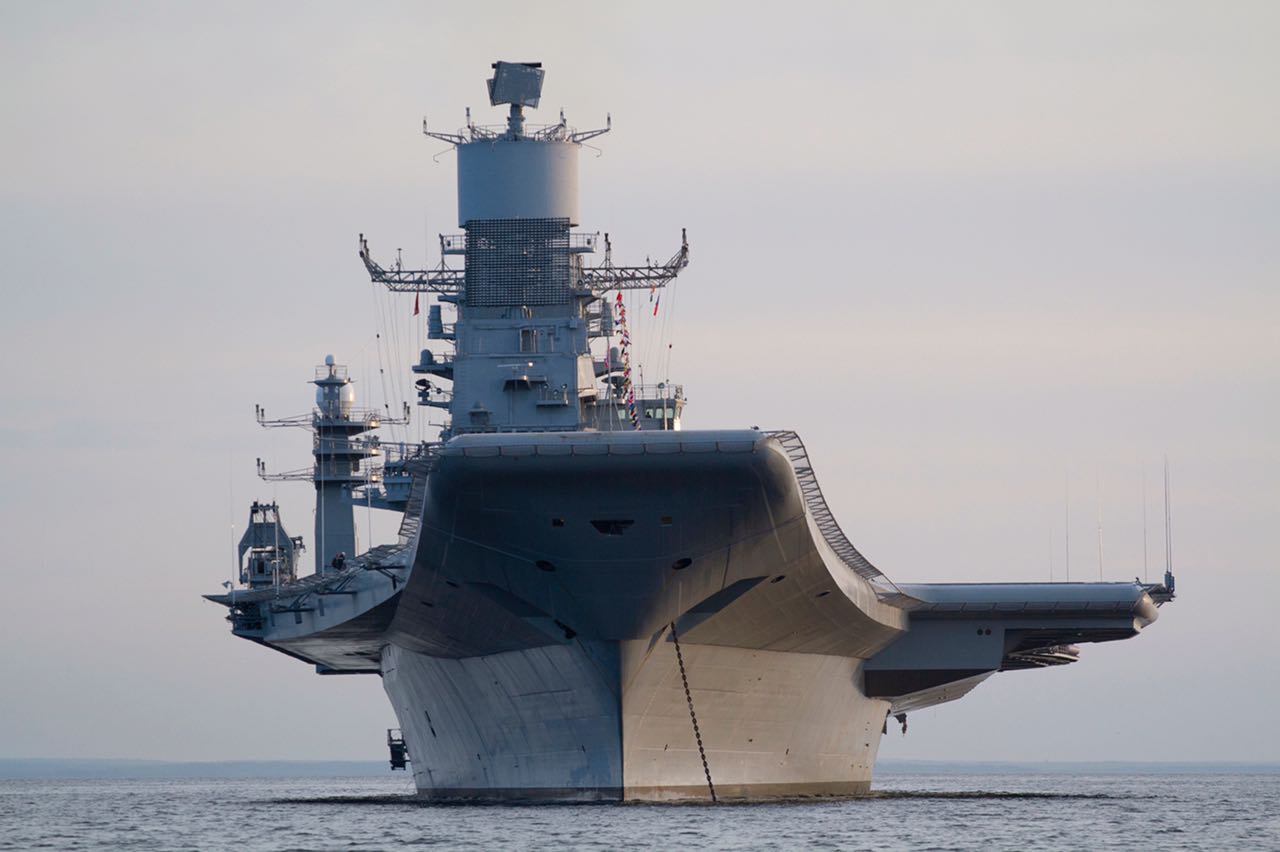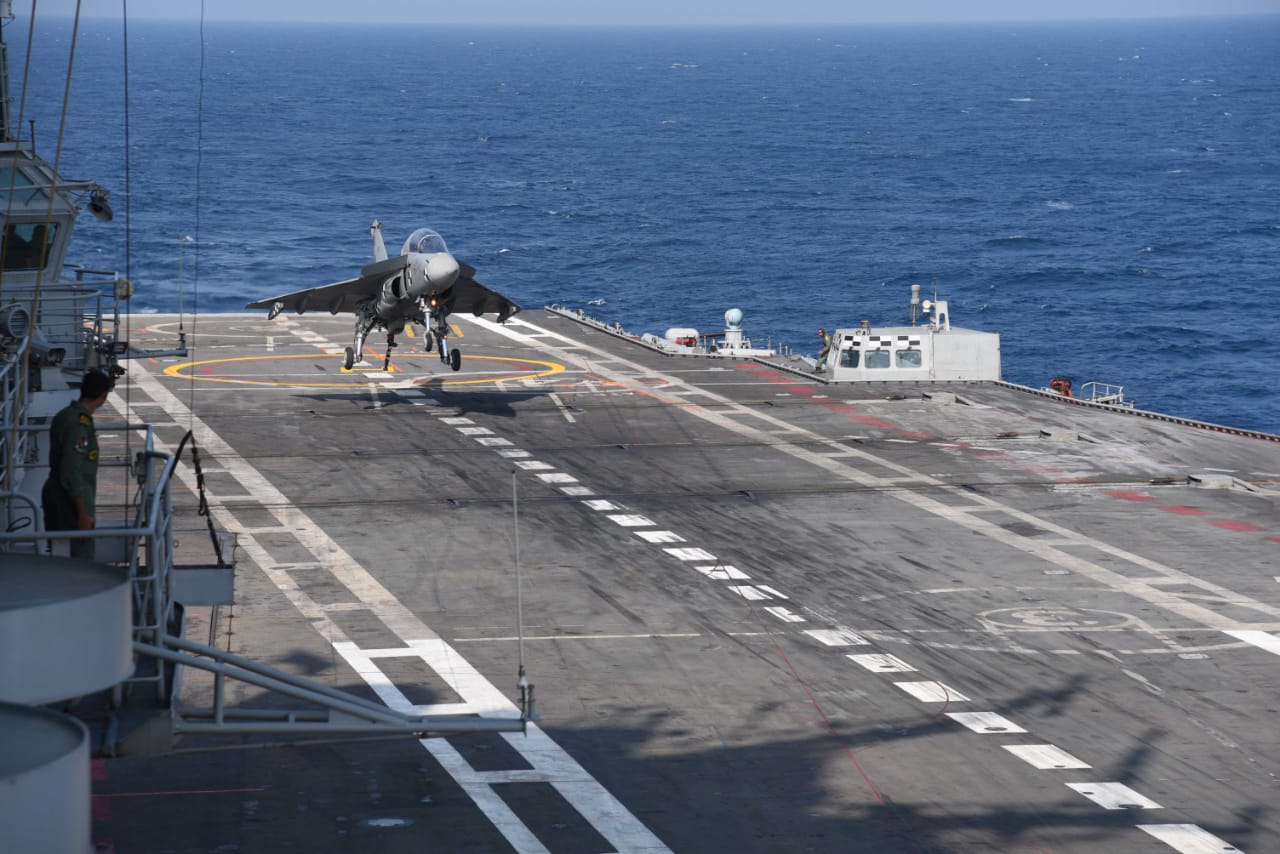With India’s first indigenous aircraft carrier INS Vikrant getting commissioned by PM Narendra Modi in a splendid ceremony at Cochin Shipyard, speculations are rife about whether New Delhi would approve the third aircraft carrier, INS Vishal (translating to Huge or Massive).
PM Narendra Modi commissions indigenous Aircraft Carrier IAC Vikrant, the largest & most complex warship ever built in India's maritime history, into the Indian Navy at a ceremony in Kochi, Kerala. #INSVikrant pic.twitter.com/CEQAX5ybYE
— ANI (@ANI) September 2, 2022
Former Chief of Defence Staff (CDS) Late General Bipan Rawat and former Chief of India’s Naval Staff Admiral Karambir Singh had divergent views on the matter.
Admiral Singh was emphatic for the Navy to have a third carrier to match China (the rationale being that while one each would be deployed on the east and west coasts, the third would be in either for maintenance and repairs or on global missions, thereby ensuring the availability of two ships at any point of time).
But General Rawat was never convinced.

INS Vishal is supposed to supplement INS Vikramaditya (ex-Admiral Gorshkov), the 46,000-tonne refurbished Russian Kiev-class vessel, and INS Vikrant, the 40,262-tonne vessel.
Both Vikramaditya and Vikrant are “ski-jump” carriers. Therefore, the Indian Navy regards a third “flat-topped” aircraft carrier, the planned 65,000-tonne, with superior power projection capabilities, as a necessity.
Besides, if former Navy Chief, Admiral Robin Dhowan, is to be believed, unlike Vikramaditya and Vikrant, that run by conventional fuels, Vishal could opt for nuclear propulsion (subsequent reports suggest that the Navy scaled down this plan to bring down the overall cost).
On December 3, 2018, the then-Chief of the Naval Staff Sunil Lanba (Admiral Dhowan’s successor) told the media that the work on INS Vishal had moved ahead and the construction of the ship was expected to begin in 3 years. It was then understood that if everything went well, the carrier would be on the sea in the early 2030s.

But that has not happened, and work has been stalled for all practical purposes. Rawat’s strong views against it did not help, particularly when there are severe financial constraints, made worse by the Covid-19 pandemic.
Arguments Against A Third Carrier
There are essentially three arguments against acquiring Vishal.
One is the cost factor. In the process of acquiring Vikramaditya from Russia, the original price rose from $974 million to $2.35 billion. When fitted with 45 MiG-29K aircraft and additional modifications, the overall price went up to nearly $7 billion.
The cost of Vikrant, including 36 aircraft (supposed to be MiG-29K fighter aircraft and Kamov-31 Air Early Warning Helicopters; the Navy is not revealing exact details of the arms and ammunition), is believed to be somewhere between $10 and $11 billion.
Analysts say that if Vishal is allowed to fructify, its total cost, supported by the anticipated aerial component of 55 F-18E or Rafale aircraft, will cost, at current prices, in the order of $16–17 billion.
The argument, therefore, is that instead of spending such a huge amount on a third carrier, the Navy, which is otherwise undergoing a resource crunch in such areas as corvettes, nine-sweepers, destroyers, frigates, naval utility helicopters, and unmanned aerial vehicles (UAVs) and other assorted missiles and ordnance, can better utilize its rather limited $4.55 billion budget in capital expenditure for the year 2021-22.
Secondly, more than “the astronomical cost” of a carrier that is meant for the nation’s “sea-control” strategy, critics point out their increasing vulnerabilities to ever-improving ballistic/cruise missiles and submarines as a part of the adversary’s anti-access/area denial (A2/AD) capability.
These days, submarines need not have to get that close to do harm. It is argued that they, like surface ships and aircraft, can also launch increasingly sophisticated anti-ship missiles from far afield. China’s H-6k bomber, for instance, has a range of 3,000km and its YJ-12 cruise missiles another 400km.
Similarly, China, India’s principal adversary, is developing long-range missiles that are maneuverable and accurate enough to hit large ships at sea. China’s DF-21D, an anti-ship ballistic missile that can travel over 1,500km (950 miles), is already a threat.
In fact, many other countries are building cheaper anti-ship cruise missiles, which fly shorter distances but can be launched from planes. Anti-ship missiles are growing in range, precision, and number, making big carriers sitting ducks in the process.
Thirdly, and this is a corollary of the above, other platforms can do the job more efficiently than carriers without lesser vulnerabilities. General Rawat was a strong proponent of the theory that Su-30MKIs armed with the BrahMos-A supersonic cruise missile can better police the Indian Ocean region against China’s expanding naval footprint in the area.
What India’s Military Chief Says
General Rawat’s supporters also say that the IAF’s maritime Jaguar IM fleet, armed with AGM-84L Block II Harpoon missiles and Israel Aerospace Industries-Elta EL/M-2052/2060 multi-mode active electronically scanned array (AESA) radar for sea-borne operations, will be much more effective than carriers in any eventual operation.
By quoting General Rawat, they argue that the Navy, on the other hand, should concentrate on developing Lakshadweep and the Andaman & Nicobar Islands as “unsinkable” Naval assets.
However, the carriers are not as defenseless as they are projected to be by the critics. Their own aircraft can protect them from incoming bombers. The escort vessels around and below them ward off unfriendly submarines and shoot down incoming missiles.
“A lot of these [carrier-killing] systems are essentially unproven,” argues Nick Childs, an expert at the International Institute of Strategic Studies, a London think-tank.
“A missile that can fly the distance required is only one part of such a system. You also need eyes that can keep track of the prey. Ground-based radar cannot see targets hundreds of kilometers out to sea. Satellites can help, but they don’t give you data of high enough quality for the necessary precision”, says Sidharth Kaushal, another expert at the Royal United Services Institute), another London think-tank.
“Bringing together different sorts of satellite and drone data to update targeting information on the fly will not be easy, not least because the target carrier’s bearing is unlikely to stay steady,” Kaushal added.
According to Vice Admiral Vijay Shankar (retd), “superior surveillance, cooperative engagement capability, mobility (a Carrier Group can move nearly 1000 km in a day), range and payload of its aircraft give it the upper hand in any tactical scenario.

The carrier, through the device of its aircraft, can hold an enemy ship or target at safe distances and then neutralize it by “standing off and delivering a lethal strike. It can, depending upon circumstances, either degrade enemy surveillance and command and control or altogether inhibit the capability to counter-attack”.
Similarly, the high-cost factor that is cited does not take into account the fact that making a carrier involves a long period, which generates huge employment opportunities, provides business to local industries, and encourages indigenous shipbuilding.
There’s no denying that aircraft carriers are expensive assets, but only when one considers their initial cost of acquisition. According to a report by the New Delhi-based Manohar Parrikar Institute for Defence Studies and Analyses (IDSA), “When this cost is divided over the average life of an aircraft carrier, which could be anywhere from 40 to 45 years, it works out similar to two destroyers with an average life span of 25 years.
This includes the fact that an aircraft carrier over its lifespan might service squadrons from two different technological generations.”
Why India Needs A Third Carrier
This being the case, the Navy’s principal arguments for having carriers in general and Vishal, in particular, are the following:
One, carriers are an essential element of sea control. According to India’s maritime doctrine, sea control is the central concept around which the Indian Navy is structured. Control of maritime space and assuring its security for any length of time is impossible without a standoff capability, and this is provided by the Carrier Group (Ship along with all its assets).

Two, functional diversity that the Carrier Group can bring to bear includes deterrence, support of amphibious operations, land-attack missions, wide-area domain awareness, command and control of large forces, and personnel evacuation.
Three, the Carrier Group can sustain the conditions for long-term offensive presence and power projection. It can, during the adversary’s preparation and build-up phase, deny free access to its bases.
Four, the operational agility, firepower, and flexibility that the Carrier Group provides to the Commander is unmatched by any other maritime force.
Five, as opposed to land forces and ground-based air forces, maritime power, particularly the Carrier Group, represents the most potent yet the least intrusive of military power because it operates in and from international waters.
All told, if the carriers are increasingly becoming irrelevant because of the “sea-denial strategy” mastered by the Chinese, why is it that China itself is developing its third carrier?
- Author and veteran journalist Prakash Nanda has been commenting on politics, foreign policy on strategic affairs for nearly three decades. A former National Fellow of the Indian Council for Historical Research and recipient of the Seoul Peace Prize Scholarship, he is also a Distinguished Fellow at the Institute of Peace and Conflict Studies. CONTACT: prakash.nanda@hotmail.com
- Article republished due to readers’ interest
- Follow EurAsian Times on Google News




